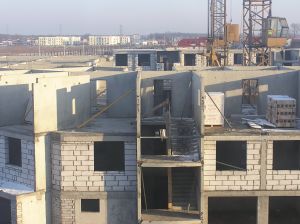The Commerce Department data released on August 19 suggests that, looking at a rolling 12-month total of multifamily starts without any seasonal adjustment, construction has hit its highest level since 1989 for the year ending in July.
This is less significant for economic growth than single-family homes, which have a bigger multiplier effect on both consumer spending and job growth, the Wall Street Journal reports.
“We will take what economic activity we can get, but our housing market model was designed in the U.S. to build a lot of single-family homes for owners, not multifamily homes for renters,” Diane Swonk, chief economist of Mesirow Financial, wrote Tuesday on the company's blog.
The boost to apartment construction, however, suggests that job gains are encouraging the creation of households, and that consumers' needs will require more construction, both for renters or for owners.
Renting has become popular, at least in part, because many Americans cannot afford the down payment for a house or can't get a mortgage, and others prefer the flexibility that comes with a lease.
Soon, however, rising rents could encourage renters to buy homes. A Labor Department report notes that rents were rising at their fastest pace in five years this July, up 3.3% from last year.
With apartment construction hitting a 25-year high, it's not surprising that apartment company stocks have been doing well. Shares of Equity Residential (EQR -0.13%) and AvalonBay Communities (AVB +0.22%) closed Tuesday at their highest levels since 1993 and 1994, when the companies went public, respectively.
Related Stories
| Sep 16, 2010
Gehry’s Santa Monica Place gets a wave of changes
Omniplan, in association with Jerde Partnership, created an updated design for Santa Monica Place, a shopping mall designed by Frank Gehry in 1980.
| Sep 16, 2010
Green recreation/wellness center targets physical, environmental health
The 151,000-sf recreation and wellness center at California State University’s Sacramento campus, called the WELL (for “wellness, education, leisure, lifestyle”), has a fitness center, café, indoor track, gymnasium, racquetball courts, educational and counseling space, the largest rock climbing wall in the CSU system.
| Sep 13, 2010
Community college police, parking structure targets LEED Platinum
The San Diego Community College District's $1.555 billion construction program continues with groundbreaking for a 6,000-sf police substation and an 828-space, four-story parking structure at San Diego Miramar College.
| Sep 13, 2010
Campus housing fosters community connection
A 600,000-sf complex on the University of Washington's Seattle campus will include four residence halls for 1,650 students and a 100-seat cafe, 8,000-sf grocery store, and conference center with 200-seat auditorium for both student and community use.
| Sep 13, 2010
Second Time Around
A Building Team preserves the historic facade of a Broadway theater en route to creating the first green playhouse on the Great White Way.
| Sep 13, 2010
Palos Community Hospital plans upgrades, expansion
A laboratory, pharmacy, critical care unit, perioperative services, and 192 new patient beds are part of Palos (Ill.) Community Hospital's 617,500-sf expansion and renovation.
| Sep 13, 2010
China's largest single-phase hospital planned for Shanghai
RTKL's Los Angles office is designing the Shanghai Changzheng New Pudong Hospital, which will be the largest new hospital built in China in a single phase.
| Sep 13, 2010
Richmond living/learning complex targets LEED Silver
The 162,000-sf living/learning complex includes a residence hall with 122 units for 459 students with a study center on the ground level and communal and study spaces on each of the residential levels. The project is targeting LEED Silver.















